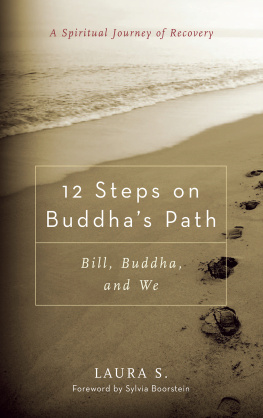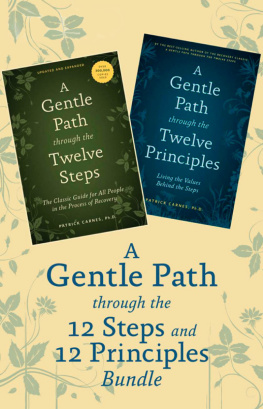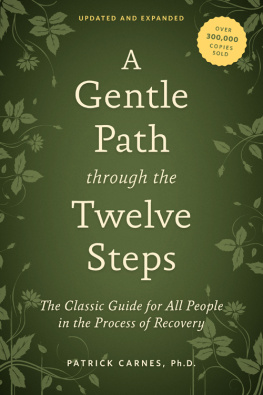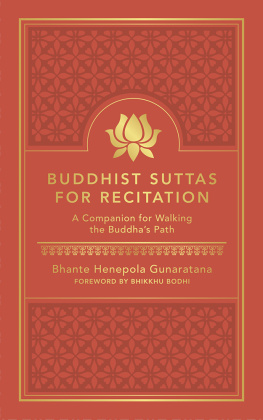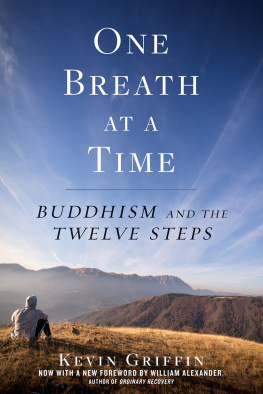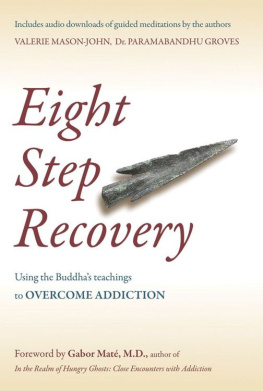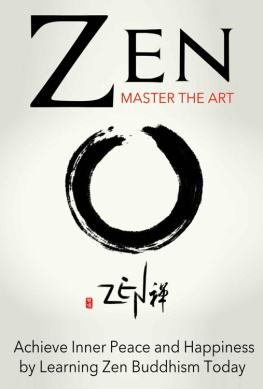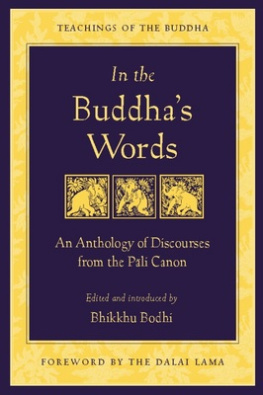Wisdom Publications, Inc.
199 Elm Street
Somerville MA 02144 USA
www.wisdompubs.org
www.SimonandSchuster.com
2006 Wisdom Publications
All rights reserved. No part of this book may be reproduced in any form or by anymeans, electronic or mechanical, including photography, recording, or by any information storage andretrieval system or technologies now known or later developed, without permission in writing fromthe publisher.
Library of Congress Cataloging-in-Publication Data
S., Laura.
12 steps on Buddha's path : Bill, Buddha, and we : a spiritual journey ofrecovery / Laura S.
p. cm.
Includes index.
ISBN 0-86171-281-1 (pbk. : alk. paper)
ISBN 978-0-86171-993-8 (ebook)
1. Twelve-step programsReligious aspectsBuddhism. 2. ReligiouslifeBuddhism. 3. AlcoholicsReligious life. 4. AlcoholismReligiousaspectsBuddhism. I. Title. II. Title: Twelve steps on Buddhas path.
BQ4570.T85S7 2006
294.3'3762292dc22
2005034846
ISBN 0-86171-281-1
Cover design by Laura Shaw.
Interior design by DCDesign, Inc. Set in Goudy 11.5/17 pt.

MAY ALL BEINGS BE WELL, HAPPY, AND FREE, ONE STEP AT A TIME, ONE MOMENT AT A TIME

CONTENTS
FOREWORD

I OFTEN HAVE the opportunity to speak about the benefits of my Buddhist meditation practice to groups of people who have no background in Buddhism. It might be at the monthly meeting of the Parent / Teacher Association of the local middle school, the Library Club of a senior residential center, the Tuesday morning breakfast meeting of the Rotary Club in a nearby town, or the spring benefit luncheon of the county Association of Family Lawyers. The ages of the people in the audience vary and their reasons for coming together are different, but my message is basically the same wherever I go:
I tell them that the Buddha taught meditations as one way of cultivating wisdom and kindness. I say that the fundamental premise behind all the practices that the Buddha taught is that it is possible to have minds that are peaceful in the middle of lives, and in the middle of a world, that are continually and inevitably problematic.
I begin with the first of the Four Noble Truths, the Buddhas summary expression of his understanding of the causes and the end of suffering. Life is difficult, he taught, inherently challenging, because it requires constant accommodation to changing, often painful, circumstances. I say the Second Noble Truth this way: Suffering is the insatiable need to have things be other than what they are. I continue with the Third Noble Truth: Peace is possible, happiness is possible, because peace and happiness in life do not depend on what is going on but rather on how the heart and mind respond to what is happening. I add that the Fourth Noble Truth is the program of practices the Buddha taught to promote the hearts wise response.
It is very often at this point that someone in the audience will say, Wait a minute. I say something like this every day. I say, God, grant me the serenity to accept the things I cannot change, the courage to change the things I can change, and the wisdom to know the difference. Isnt that what youre saying?
I say, Yes. It is.
The idiom of the 2,500-year-old Buddhist tradition and the idiom of contemporary Twelve Step teachings are different, but both paths share the powerful message of the possibility of peace and happiness. The author of this book has used her own experience in decades of Twelve Step work and as a Buddhist meditator as the vehicle for presenting both practice paths. As I read these parallel reflections, echoing the promise of the end of suffering back and forth between them, the promise of liberation from suffering sounded stronger and stronger, as if two familiar voices were calling out Yes! and Amen! to each other. I finished the book inspired. It renewed my zeal. I think it will do the same for you.
The author, writing under the pseudonym Laura S., offers this book anonymously, in respect to the Twelve Step commitment to anonymity and in the understanding that no one does anything alone. Everything anyone does is an expression of all the circumstances, connections, and communities that have been part of that persons experience. Laura S., Bill W., the Buddha, and We all wrote this book. May all of us and all beings share in its merit.
S YLVIA B OORSTEIN
S PRING 2006
PREFACE

O N MY THIRTY-THIRD birthday I swallowed a bottleful of sleeping pills and died: in the ambulance to the hospital, I stopped breathing and my heart stopped beating.
No one who knew me could comprehend what had driven the person they saw as an intelligent, attractive, successful business-woman to such a desperate act. On the outside, everything about my life looked rich; inside, I was emotionally and spiritually bankrupt. I woke up every morning crying because I was still alive. I was in unbearable emotional pain and I couldnt imagine that anything would ever change. I just had to hang on as long as I could, then find a way to end the painand me. In the next two years I made two other serious suicide attempts, spent time in locked wards of mental hospitals, and lost all the things that had made my life look good on the outsidecareer, partner, home, car, sailboat, and above all, my heavily defended faade. I was broke and broken.
After I lost everything that propped up my faade, I was able to cut through my denial, one of the most pervasive characteristics of the disease of alcoholism, and come face to face with the fact that I was a drunk and that the medicine I took to get through my life was fueling the depression that almost ended it. Destitute and unable to work, I was brought to my knees and then I reached out for help. I did what until then had been unimaginable: I went to Alcoholics Anonymous. There I was surrounded by people who told me that they knew how I felt, and I knew that they did because they too had been trapped in the despair-filled cycle of alcoholism, and I let them love me back to life.
Slowly, fighting the desire to drink again, sometimes fighting the program that was helping me not give in to that compulsion, I eventually experienced rebirth: a new life unlike any I could have imagined. My struggle with the disease of alcoholism as I began my spiritual journey in Alcoholics Anonymous is portrayed in Part One of this book. As rewarding as my recovery was, I still found myself in a spiritual search for something to fill the black hole inside that was smaller but still there. Much to my surprise, because I had intellectually rejected it as a teenager, I found what I was looking for in Buddhism. As the result of some extraordinary experiences in the Himalayas, that attraction to Buddhism finally made the crucial twelve-inch drop from my head to my heart, a passage described in Part Two.
When I started out in AA, I thought I could carefully read the Twelve Steps and master the program of recovery. When I began to investigate Buddhism, I thought I could thoroughly study the Four Noble Truths and master the teachings of the Buddha. I was wrong in both cases. For me, the process has been something like nurturing an orchid seedpod, which takes seven years to bloom. If a seedpod is from an existing, well-established species, we can anticipate what its flower will look likejust as we can see around us examples of what recovery is like for someone in AA or how practice transforms someone who is a Buddhist. But if were creating an orchid hybrid, we have no idea what were going to get at the end of the seven years. It may look as if nothing is happening to the seedpod for years, but on the inside rare beauty is being created if we continuously nurture the seedpod and our own faith.
Next page
